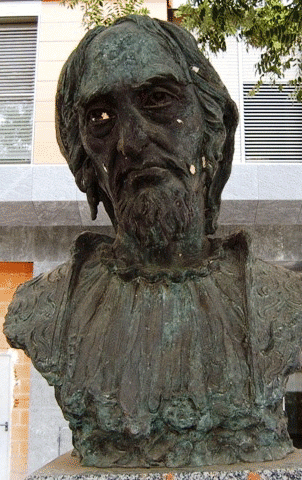Moses de León
(1240 - 1305)
Moses ben Shem Tov de León was a Spanish rabbi and Kabbalist who is believe to be the author of the Zohar.
de León lived in
Muslim Spain and little to nothing is known of his
upbringing, his teachers or his early studies. Apart from religious
study, de León was apparently attracted to philosophy - Maimonides' Guide for the Perplexed was copied for him in 1264.
Moses subsequently turned to Kabbalah, and, while wandering among the communities of Castile, he became
friendly with the kabbalists there. He immersed himself in Kabbalistic lore.
 Statue of de Leon in Spain
Statue of de Leon in Spain |
Moved by an unusual enthusiasm,
combined with the urge to counteract the influence of certain
rationalistic trends, Moses composed various writings toward the
close of the 1270s. He credited ancient scholars and sages as the
authors of these works, probably to give them more authority. They
were designed to propagate the doctrine of Kabbalism in the pattern in which it had crystallized in his own mind.
Completed before 1286 they form the
Midrash ha-Ne'elam, or "Mystical Midrash," and are the main
substance of the Zohar. (The later stratum in this composite
work was written by another kabbalist.)
The major part of these writings is
in Aramaic, but Moses also composed Hebrew pseudepigraphica on ethics
and the eschatology of the soul.
The "Testament of R. Eliezer
the Great," also called Orhot Chayyim, is evidence of the
author's hesitations in choosing between the tannaim Eliezer
b. Hyrcanus and Shimon b. Yochai as the hero of his most famous book,
the Zohar. He also intended to compose a new Book of Enoch,
parts of which he embodies in his Mishkan ha- Edut.
For a number of years, during the
composition of the Zohar, and at least until 1291, he resided
in Guadalajara, circulating from his home the first parts of the Zohar,
which included a different version of the Midrash ha-Ne'elam.
The Hebrew writings which bear his
name are based on the same sources as those utilized in the Zohar and they frequently make veiled allusions to it without specifying it
by name. These writings and the portions of the Zohar composed
by Moses frequently serve to clarify one another; the former can be
regarded as the authentic exegesis of the doctrine enshrined in the Zohar.
In its literary form the Zohar is a collection of several books or sections which include short midrashic statements, longer homilies, and discussions on many topics. Moses De
León credited Shimon bar Yochai as the author, but there are also
long anonymous sections.
It is not one book in the accepted
sense of the term, but a complete body of literature which has been
united under an inclusive title.
In the printed editions the Zohar is composed of five volumes. According to the division in most
editions, three of them appear under the name Sefer ha-Zohar al
ha-Torah; one volume bears the title Tikkunei ha-Zohar;
the fifth, entitled Zohar Chadash, is a collection of sayings
and texts found in the manuscripts of the Tzfat kabbalists after the printing of the Zohar.
The main part of the Zohar is arranged according to the weekly
portions of the Torah,
up to and including the portion Pinchas, Numbers
29. From Deuteronomy only
parts of three Torah portions are included
Basically it is a Kabbalistic Midrash on the Torah, mixed
with short statements, long expositions, and narratives concerning
Shimon b. Yochai and his companions.
Some of it consists also of common
legends.
The number of verses interpreted in
each portion is relatively small. Often the exposition digresses to
other subjects quite divorced from the actual text of the portion,
and some of the interpretations are quite skillfully constructed.
Many stories act as a framework for
the homilies of the companions: conversations while they are on a
journey or when they rest for the night.
The Zohar became a
best-seller, the basic groundwork text for all subsequent Kabbalists.
Sources: Gates
to Jewish Heritage. Photo Courtesy of Wikipedia Commons author Sonsaz |